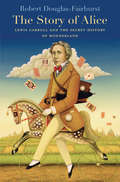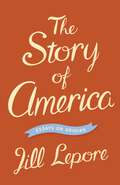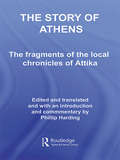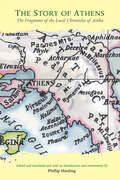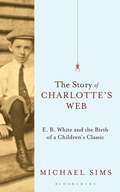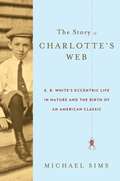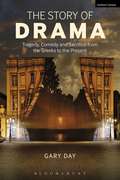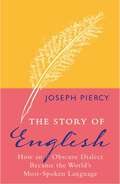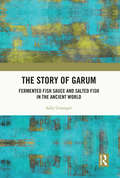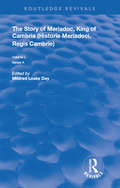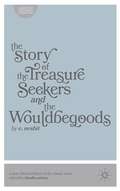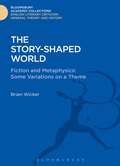- Table View
- List View
The Story of Alice: Lewis Carroll And The Secret History Of Wonderland
by Robert Douglas-FairhurstRobert Douglas-Fairhurst illuminates two entangled lives: the Oxford mathematician Charles Dodgson (Lewis Carroll) and Alice Liddell, the child for whom he invented the Alice stories. This relationship influenced Carroll’s imaginative creation of Wonderland—a sheltered world apart during the stormy transition from the Victorian to the modern era.
The Story of America: Essays on Origins
by Jill LeporeIn The Story of America, Harvard historian and New Yorker staff writer Jill Lepore investigates American origin stories--from John Smith's account of the founding of Jamestown in 1607 to Barack Obama's 2009 inaugural address--to show how American democracy is bound up with the history of print. Over the centuries, Americans have read and written their way into a political culture of ink and type. Part civics primer, part cultural history, The Story of America excavates the origins of everything from the paper ballot and the Constitution to the I.O.U. and the dictionary. Along the way it presents fresh readings of Benjamin Franklin's Way to Wealth, Thomas Paine's Common Sense, "The Raven" by Edgar Allan Poe, and "Paul Revere's Ride" by Henry Wadsworth Longfellow, as well as histories of lesser-known genres, including biographies of presidents, novels of immigrants, and accounts of the Depression. From past to present, Lepore argues, Americans have wrestled with the idea of democracy by telling stories. In this thoughtful and provocative book, Lepore offers at once a history of origin stories and a meditation on storytelling itself.
The Story of America: Essays on Origins
by Jill LeporeIn The Story of America, Harvard historian and New Yorker staff writer Jill Lepore investigates American origin stories--from John Smith's account of the founding of Jamestown in 1607 to Barack Obama's 2009 inaugural address--to show how American democracy is bound up with the history of print. Over the centuries, Americans have read and written their way into a political culture of ink and type. Part civics primer, part cultural history, The Story of America excavates the origins of everything from the paper ballot and the Constitution to the I.O.U. and the dictionary. Along the way it presents fresh readings of Benjamin Franklin's Way to Wealth, Thomas Paine's Common Sense, "The Raven" by Edgar Allan Poe, and "Paul Revere's Ride" by Henry Wadsworth Longfellow, as well as histories of lesser-known genres, including biographies of presidents, novels of immigrants, and accounts of the Depression. From past to present, Lepore argues, Americans have wrestled with the idea of democracy by telling stories. In this thoughtful and provocative book, Lepore offers at once a history of origin stories and a meditation on storytelling itself.
The Story of Athens: The Fragments of the Local Chronicles of Attika (Routledge Sourcebooks for the Ancient World)
by Phillip HardingA leading authority in the field, Phillip Harding presents the very first English translations of the six Athenian writers known as the Atthidographers. In his vivid and detailed history, Harding examines the remaining fragments of these historical writers' work – in chronological order – and how these writings, dating from the fifth and fourth century BC, reveal an invaluable wealth of information about early Athenian history, legend, religion, customs and anecdotes. Harding also goes on to study how these histories of Athens and its people were the source for later surviving historians such as Plutarch and Diodorus. With the aid of linking text and detailed annotation, anyone with an interest in Athenian history, classical Greece need look no further.
The Story of Athens: The Fragments of the Local Chronicles of Attika (Routledge Sourcebooks for the Ancient World)
by Phillip HardingA leading authority in the field, Phillip Harding presents the very first English translations of the six Athenian writers known as the Atthidographers. In his vivid and detailed history, Harding examines the remaining fragments of these historical writers' work – in chronological order – and how these writings, dating from the fifth and fourth century BC, reveal an invaluable wealth of information about early Athenian history, legend, religion, customs and anecdotes. Harding also goes on to study how these histories of Athens and its people were the source for later surviving historians such as Plutarch and Diodorus. With the aid of linking text and detailed annotation, anyone with an interest in Athenian history, classical Greece need look no further.
The Story of Be: A Verb's-Eye View of the English Language
by David CrystalIt's the most simple, unassuming, innocent-looking verb: 'to be'. Yet it is jam-packed with more different meanings, forms, and uses than any other English word. As he reveals be's multiple incarnations, David Crystal takes us to the heart of our flexible and changing language. He tells the intriguing story in 26 chapters, each linked to a particular usage. We meet circumstantial be ('how are you?'), numerical be ('two and two is four'), quotative be ('so I was like, "wow"'), and ludic be ('oh no he isn't!'), and a whole swarm of other meanings. Bringing the ideas to life are a host of examples from sources as varied as Beowulf, Jane Austen, pantomime, Hamlet (of course), and Star Wars, with cartoons from Ed McLachlan and Punch peppered throughout. Full of fascinating nuggets of information, it is a book to delight any lover of words and language.
The Story of Be: A Verb's-Eye View of the English Language
by David CrystalIt's the most simple, unassuming, innocent-looking verb: 'to be'. Yet it is jam-packed with more different meanings, forms, and uses than any other English word. As he reveals be's multiple incarnations, David Crystal takes us to the heart of our flexible and changing language. He tells the intriguing story in 26 chapters, each linked to a particular usage. We meet circumstantial be ('how are you?'), numerical be ('two and two is four'), quotative be ('so I was like, "wow"'), and ludic be ('oh no he isn't!'), and a whole swarm of other meanings. Bringing the ideas to life are a host of examples from sources as varied as Beowulf, Jane Austen, pantomime, Hamlet (of course), and Star Wars, with cartoons from Ed McLachlan and Punch peppered throughout. Full of fascinating nuggets of information, it is a book to delight any lover of words and language.
The Story of Charlotte's Web: E. B. White and the Birth of a Children's Classic
by Michael SimsWhile composing what would become his most enduring and popular book, Charlotte's Web, E. B. White was obeying that oft-repeated maxim: 'Write what you know.' Helpless pigs, silly geese,clever spiders, greedy rats - White knew all of these characters in the barns and stables where he spent his favourite hours as child and adult. Painfully shy, White once wrote of himself 'this boy felt for animals a kinship he never felt for people'. Nonetheless, that tens of millions have been so moved by Charlotte's Web, and by White's other classics, testifies to his deep understanding of the human condition.Bringing readers into intimate contact with E. B. White's world, Michael Sims chronicles his animal-rich youth and dreams of being a writer; the vibrant early years of the New Yorker,where urban nature was White's ever-present theme; the discovery of the farm in Maine where he and his wife would live; his fascinating scientific research into how spiders spin webs, lay eggs, and live in the world; his friendship with his legendary editor, Ursula Nordstrom; and the luminous creative process that led to publication of his masterpiece.By refining the raw ore of his childhood in Mount Vernon, New York, in the first decade of the twentieth century, White translated his own passions and contradictions, delights and fears, into a book that would be read the world over. The Story of Charlotte's Web illuminates the life of a literary icon, and will add richness and appreciation for anyone who has loved, or has yet to read, a cherished classic.
The Story of Charlotte's Web: E. B. White's Eccentric Life in Nature and the Birth of an American Classic
by Michael SimsWhile composing what would become his most enduring and popular book, E. B. White obeyed that oft-repeated maxim: "Write what you know." Helpless pigs, silly geese, clever spiders, greedy rats-White knew all of these characters in the barns and stables where he spent his favorite hours as a child and adult. Painfully shy, "this boy," White once wrote of himself, "felt for animals a kinship he never felt for people." It's all the more impressive, therefore, how many people have felt a kinship with E. B. White.Michael Sims chronicles White's animal-rich childhood, his writing about urban nature for the New Yorker, his scientific research into how spiders spin webs and lay eggs, his friendship with his legendary editor, Ursula Nordstrom, the composition and publication of his masterpiece, and his ongoing quest to recapture an enchanted childhood.
The Story of Drama: Tragedy, Comedy and Sacrifice from the Greeks to the Present
by Gary DayTracing the history of tragedy and comedy from their earliest beginnings to the present, this book offers readers an exceptional study of the development of both genres, grounded in analysis of landmark plays and their context. It argues that sacrifice is central to both genres, and demonstrates how it provides a key to understanding the grand sweep of Western drama. For students of literature and drama the volume serves as an accessible companion to over two millennia of drama organised by period, and reveals how sacrifice represents a through-line running from classical drama to today's reality TV and blockbuster movies.Across the chapters devoted to each period, Day explores how the meanings of sacrifice change over time, but never quite disappear. He charts the influences of religion, social change and politics on the status and purposes of theatre in each period, and on the drama itself. But it is through a close study of key plays that he reveals the continuities centred around sacrifice that persist and which illuminate aspects of human psychology and social organisation.Among the many plays and events considered are Aeschylus' trilogy The Oresteia, Aristophanes' Women at the Thesmorphia, Menander's The Bad-Tempered Man, the spectacles of the Roman Games, Seneca's The Trojan Women, Plautus's The Rope, the Cycle plays and Everyman from the Middle Ages, Shakespeare's King Lear and A Midsummer Night's Dream, Middleton's The Revenger's Tragedy, Jonson's Every Man in His Humour, Thomas Otway's The Orphan, William Wycherley's The Country Wife, Wilde's A Woman of No Importance, Beckett' Waiting for Godot, Tennessee Williams's A Streetcar Named Desire, Suzan-Lori Parks's Topdog/Underdog, Sarah Kane's Blasted and Charlotte Jones' Humble Boy. A conclusion examines the persistence of ideas of sacrifice in today's reality TV and blockbuster movies.
The Story of Drama: Tragedy, Comedy and Sacrifice from the Greeks to the Present
by Gary DayTracing the history of tragedy and comedy from their earliest beginnings to the present, this book offers readers an exceptional study of the development of both genres, grounded in analysis of landmark plays and their context. It argues that sacrifice is central to both genres, and demonstrates how it provides a key to understanding the grand sweep of Western drama. For students of literature and drama the volume serves as an accessible companion to over two millennia of drama organised by period, and reveals how sacrifice represents a through-line running from classical drama to today's reality TV and blockbuster movies.Across the chapters devoted to each period, Day explores how the meanings of sacrifice change over time, but never quite disappear. He charts the influences of religion, social change and politics on the status and purposes of theatre in each period, and on the drama itself. But it is through a close study of key plays that he reveals the continuities centred around sacrifice that persist and which illuminate aspects of human psychology and social organisation.Among the many plays and events considered are Aeschylus' trilogy The Oresteia, Aristophanes' Women at the Thesmorphia, Menander's The Bad-Tempered Man, the spectacles of the Roman Games, Seneca's The Trojan Women, Plautus's The Rope, the Cycle plays and Everyman from the Middle Ages, Shakespeare's King Lear and A Midsummer Night's Dream, Middleton's The Revenger's Tragedy, Jonson's Every Man in His Humour, Thomas Otway's The Orphan, William Wycherley's The Country Wife, Wilde's A Woman of No Importance, Beckett' Waiting for Godot, Tennessee Williams's A Streetcar Named Desire, Suzan-Lori Parks's Topdog/Underdog, Sarah Kane's Blasted and Charlotte Jones' Humble Boy. A conclusion examines the persistence of ideas of sacrifice in today's reality TV and blockbuster movies.
The Story of English: How the English language conquered the world
by Philip GoodenBorn as a Germanic tongue with the arrival in Britain of the Anglo-Saxons in the early medieval period, heavily influenced by Norman French from the 11th century, and finally emerging as modern English from the late Middle Ages, the English language has grown to become the linguistic equivalent of a superpower.Worldwide some 380 million people speak English as a first language and some 600 million as a second language. A staggering one billion people are believed to be learning it. English is the premier international language in communications, science, business, aviation, entertainment, and diplomacy, and also on the Internet and is thought by many to be well on the way to becoming the world's first universal language. Philip Gooden tells the story of the English language in all its richness and variety. From the intriguing origins and changing definitions of common words such as 'OK', 'beserk', 'curfew', 'cabal' and 'pow-wow', to the massive transformations wrought in the vocabulary and structure of the language by Anglo-Saxon and Norman conquest, through to the literary triumphs of Beowulf, The Canterbury Tales and the works of Shakespeare, right up to the profound and surprising effect electronic media, and in particular the Internet, has had on its development.
The Story of English: How an Obscure Dialect Became the World's Most-Spoken Language
by Joseph PiercyThe Story of English illustrates the compelling history of how the relatively obscure dialects spoken by tribes from what are now Denmark, the Low Countries and northern Germany, became the most widely spoken language in the world, and of how that language evolved during the last two millennia. Chronologically ordered and divided into six main sections covering pre-Roman and Latin influences, the ascent of Old English, and the succession of Middle English, Early Modern and then Late Modern English to today's global language, this fascinating book also explores such factors as the history of the printing press, the works of Chaucer, the evolution of The American Dictionary of the English Language - commonly known as Webster's - and the magisterial Oxford English Dictionary, to the use of slang in today's speech and the coming of electronic messaging: language for a post-modern world.The Story of English is a great book for any lover not just of English, but of the history and development of language.
The Story of Garum: Fermented Fish Sauce and Salted Fish in the Ancient World
by Sally GraingerThe Story of Garum recounts the convoluted journey of that notorious Roman fish sauce, known as garum, from a smelly Greek fish paste to an expensive luxury at the heart of Roman cuisine and back to obscurity as the Roman empire declines. This book is a unique attempt to meld the very disparate disciplines of ancient history, classical literature, archaeology, zooarchaeology, experimental archaeology, ethnographic studies and modern sciences to illuminate this little understood commodity. Currently Roman fish sauce has many identities depending on which discipline engages with it, in what era and at what level. These identities are often contradictory and confused and as yet no one has attempted a holistic approach where fish sauce has been given centre stage. Roman fish sauce, along with oil and wine, formed a triad of commodities which dominated Mediterranean trade and while oil and wine can be understood, fish sauce was until now a mystery. Students and specialists in the archaeology of ancient Mediterranean trade whether through amphora studies, shipwrecks or zooarchaeology will find this invaluable. Scholars of ancient history and classics wishing to understand the nuances of Roman dining literature and the wider food history discipline will also benefit from this volume.
The Story of Garum: Fermented Fish Sauce and Salted Fish in the Ancient World
by Sally GraingerThe Story of Garum recounts the convoluted journey of that notorious Roman fish sauce, known as garum, from a smelly Greek fish paste to an expensive luxury at the heart of Roman cuisine and back to obscurity as the Roman empire declines. This book is a unique attempt to meld the very disparate disciplines of ancient history, classical literature, archaeology, zooarchaeology, experimental archaeology, ethnographic studies and modern sciences to illuminate this little understood commodity. Currently Roman fish sauce has many identities depending on which discipline engages with it, in what era and at what level. These identities are often contradictory and confused and as yet no one has attempted a holistic approach where fish sauce has been given centre stage. Roman fish sauce, along with oil and wine, formed a triad of commodities which dominated Mediterranean trade and while oil and wine can be understood, fish sauce was until now a mystery. Students and specialists in the archaeology of ancient Mediterranean trade whether through amphora studies, shipwrecks or zooarchaeology will find this invaluable. Scholars of ancient history and classics wishing to understand the nuances of Roman dining literature and the wider food history discipline will also benefit from this volume.
The Story of Meriadoc, King of Cambria (Routledge Revivals)
by Mildred Leake DayPublished in 1988: The Story of Meriadoc, King of Cambria is about a prince of the kingdom of Cambria (pre-Saxon Wales) who after surviving an attempted assassination by his uncle, fights as a young Knight in the cause of royal justice.
The Story of Meriadoc, King of Cambria (Routledge Revivals)
by Mildred Leake DayPublished in 1988: The Story of Meriadoc, King of Cambria is about a prince of the kingdom of Cambria (pre-Saxon Wales) who after surviving an attempted assassination by his uncle, fights as a young Knight in the cause of royal justice.
The Story of Muhammad Hanafiyyah: A Medieval Muslim Romance (Bibliotheca Indonesica)
by L. F. BrakelThis book may be considered to be Volume II of the Hikayat Muhammad Hanafiyyah, the text edition which appeared in 1975 as number 12 in the same series. When mention is made of "Volume I", it is the latter which is referred to. The present publication contains first and foremost an abbreviated translation of the Malay text. With regard to the rather repetitious and cliche-ridden character of the latter, it was believed that little was to be gained by a literal word-for-word translation. I hope that little essential has been left out and that the flavour of the original has percolated through to the English rendering ! For this purpose I have especially endeavoured to render many dia logues as 'verbatim' as feasible. The translation has been accompanied by notes whose main purpose it is to enable a running comparison with the Persian original. Copious quotations of the Malay and Persian texts should enable the expert reader to reach his own conclusions. Another feature of this second volume is the commentaries that follow some of the chapters trans lated. Their purpose is to determine the position of the account of the H. M. H.
The Story of Myth
by Sarah Iles JohnstonSarah Iles Johnston argues that the nature of myths as gripping tales starring vivid characters enabled them to do their most important work: sustaining belief in the gods and heroes of Greek religion. She shows how Greek myths—and the stories told by all cultures—affect our shared view of the cosmos and the creatures who inhabit it.
The Story of the Odyssey
by Stephen V. TracyHere Stephen Tracy offers a vivid, fast-paced narrative that serves as a reading guide to Homer's monumental epic. He not only provides translations of key passages and traces the evolution of major themes in the Odyssey, but also helps new readers to understand the artistry of one of the best tales ever told. Aimed at advanced readers as well, this book stresses an appreciation of how Homer has ordered his narrative, covering such topics as character interaction, family relationships, elements of poetic language, and the symbolic treatment of death, rebirth, growth, and knowledge. Given the controversy over the way the Odyssey was composed and handed down, Tracy concentrates on presenting the poem as a highly unified work. His analysis of the narrative structure reveals the epic to be arranged as a series of parallel journeys. The journey, seen here as a symbol of growth and self-knowledge, is among the major themes discussed in detail, along with the importance of women as overseers of life's journeys and the need for the sons of heroes to grow up worthy of their fathers.
The Story of the Odyssey
by Stephen V. TracyHere Stephen Tracy offers a vivid, fast-paced narrative that serves as a reading guide to Homer's monumental epic. He not only provides translations of key passages and traces the evolution of major themes in the Odyssey, but also helps new readers to understand the artistry of one of the best tales ever told. Aimed at advanced readers as well, this book stresses an appreciation of how Homer has ordered his narrative, covering such topics as character interaction, family relationships, elements of poetic language, and the symbolic treatment of death, rebirth, growth, and knowledge. Given the controversy over the way the Odyssey was composed and handed down, Tracy concentrates on presenting the poem as a highly unified work. His analysis of the narrative structure reveals the epic to be arranged as a series of parallel journeys. The journey, seen here as a symbol of growth and self-knowledge, is among the major themes discussed in detail, along with the importance of women as overseers of life's journeys and the need for the sons of heroes to grow up worthy of their fathers.
The Story of the Treasure Seekers and The Wouldbegoods (Classics of Children's Literature)
by E Nesbit Claudia NelsonThe first critical edition of the beloved classics that established Edith Nesbit as a major children's writer provides extensive guidance to help today's reader navigate the enchanting world of the Bastable family. Nelson situates Nesbit's groundbreaking stories in the context of British popular culture at the dawn of the twentieth century.
The Story Performance Handbook
by R. Craig RoneyThe Story Performance Handbook provides specific, detailed information to help adults develop basic skills in reading aloud, mediated storytelling, and storytelling. Organized sequentially, each chapter moves the reader from the easiest (reading aloud picture books) to the most difficult (creating your own stories for telling) storytelling experience, cumulatively building story performance skill in selecting, preparing, and delivering stories and poetry to audiences. This structure allows individuals to begin reading at various points depending on their prior experience with story performance. The text includes several features that make learning to perform stories and poetry easy to understand and manage: * Explicit, thorough advice avoids confusion, such as how to select, prepare, and deliver stories and poetry via reading aloud, mediated storytelling, and storytelling. * The sequential chapter organization, progressing from easiest to most difficult, and Developmental and Culminating Activities at the end of each skill chapter, enable this text to be used either independently or in conjunction with courses or workshops in story performance. * Unique among story performance texts, instruction is based not only on the author's own extensive experience but also on empirical research related to teaching adults to tell stories. * Specific information is easily located throughout the text: Processes are presented in bold type, numbered sequentially and, at the end of specific chapters, skill building activities are provided. Figures (which provide additional detailed information) are boxed. Examples of processes are highlighted with background shading.
The Story Performance Handbook
by R. Craig RoneyThe Story Performance Handbook provides specific, detailed information to help adults develop basic skills in reading aloud, mediated storytelling, and storytelling. Organized sequentially, each chapter moves the reader from the easiest (reading aloud picture books) to the most difficult (creating your own stories for telling) storytelling experience, cumulatively building story performance skill in selecting, preparing, and delivering stories and poetry to audiences. This structure allows individuals to begin reading at various points depending on their prior experience with story performance. The text includes several features that make learning to perform stories and poetry easy to understand and manage: * Explicit, thorough advice avoids confusion, such as how to select, prepare, and deliver stories and poetry via reading aloud, mediated storytelling, and storytelling. * The sequential chapter organization, progressing from easiest to most difficult, and Developmental and Culminating Activities at the end of each skill chapter, enable this text to be used either independently or in conjunction with courses or workshops in story performance. * Unique among story performance texts, instruction is based not only on the author's own extensive experience but also on empirical research related to teaching adults to tell stories. * Specific information is easily located throughout the text: Processes are presented in bold type, numbered sequentially and, at the end of specific chapters, skill building activities are provided. Figures (which provide additional detailed information) are boxed. Examples of processes are highlighted with background shading.
The Story-Shaped World: Fiction and Metaphysics: Some Variations on a Theme (Bloomsbury Academic Collections: English Literary Criticism)
by Brian WickerStory-telling, since its earliest beginnings, has drawn its power not simply from the intrinsic fascination of a skilful narrative but from the fact that human beings are compelled to make 'fictions' if they are to explain and come to terms with the world they experience. This holds true, as Mr Wicker shows in the course of a profound and wide-ranging enquiry, for the complex and often sophisticated novels and anti-novels of our own day just as much as for such traditional forms as myth and fairy-tale. The world remains 'story-shaped'.
